Firefighter Training that are Perfect for Crossfit and Cardio!
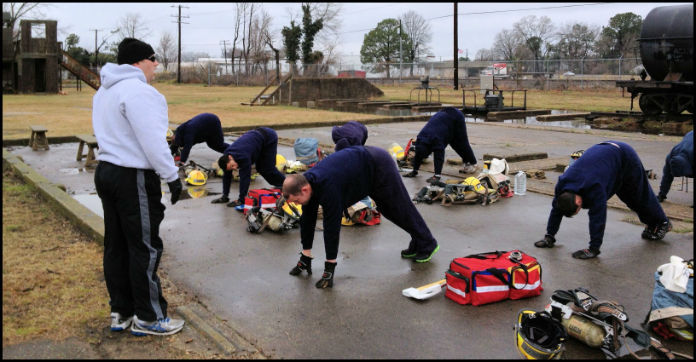
Firefighter Training has been getting some serious spotlight in the world of fitness and health. Somehow, it has been theorized, and even proven, that firefighter training can actually be a perfect Crossfit and Cardio exercise.
Firefighter training is taking on the trends right now. Many are already familiar with what this is and how this works. But, for those who are still curious and have questions in their minds, do not worry. Sit back and relax, because this article will give you the scoop of what’s happening.
What is Firefighter Training?
You might be surprised on what it takes to be a firefighter. Actually, it requires little formal education to be qualified for the position of being a firefighter. You can be a firefighter even if you are just a high school graduate! However, some companies also require and associate’s or bachelor’s degree in order to qualify.
To become a firefighter, a person needs to meet certain standards that are required by that certain department. Furthermore, that person needs to pass a particular civil service and physical agility exam.
Even though, it may look as easy as you read this, being a firefighter also requires a ton of guts. Firemen are responsible for protecting the general safety of the public through taking a course of extensive action whenever there are fire emergencies.
The work is never easy. Firemen risk their lives in order to put those who are most in need first. Their job is death-defying and requires careful planning and extensive training. The question is, how do firefighters prepare for this kind of scenarios? How do they train themselves to be equipped with the skills necessary to save peoples lives?
How do Firefighters Train?
Firemen spend extensive amount of time and effort in order to ensure quality performance when serving for the public. Hundred, even thousands, of lives depend on them on a daily basis. So, there is a need to focus significantly on how they train for these cases.
Aside from the adrenaline rush that can help boost them to become instant supermen. Still, they need to develop the sense of body awareness to help them perform their jobs accurately. Sets of particular skills are needed in this field of work. Firefighters train to improve their strength, develop power, increase speed ability and upgrade body coordination.
Before we proceed to how they seriously train for accuracy and perfection, let us take a minute to imagine a fireman in a fire situation. The fireman is clothed in thick and air-proof materials, wears heavy and thick boots and to top it off, they wear a one of a kind helmet that is as heavy as a thanksgiving turkey. It does not stop there! The fireman also holds a 20 lb ax, carries an air tank close to 50 lbs and has to sprint through fire and falling debris.
Now, that you have a (hopefully) vivid picture of what a fireman does (not to mention, those are only the basics), let us go ahead and delve in to the details.
Improve your Functional Strength through Various Planes
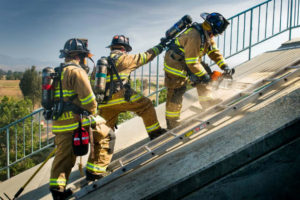
When a firefighter goes in action to save people’s lives they sprint through buildings, highs and lows. So, it is important to condition your body to be used to different levels of planes and slopes. This does not only improve your speed ability, but also your muscle strengths. Particularly, on the leg area.
There are two variations of plane motion: frontal and horizontal. The standing dumbbell side raise is a perfect example of a frontal plane workout. Also, if you have been doing cable chops for core strengthening, then you are already aware of the horizontal plane.
In the workout regimen of firefighters, they do this kind of workout alternatively and in a particular amount of seconds. Usually, they start with an easy 30 second workout for 3 sets. Then, move up to a total of 60 seconds per exercise.
Sample exercises for this functional strength are:
- Front lunge going to side lunge
- Reverse lunge going to side lunge
- Step-up to a side raise
- Single leg deadlift to side lunge
- Push-up with rotation
- Push-up with dumbbell row
Explosive Jump Training
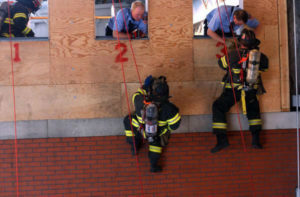
This type of training is important for firefighters. They might never know when they need to use their leg muscles and joints to leap feet away from one area to another. Especially, in cases wherein they need to use windows as their primary entrance and exit. The Medicine balls are extremely helpful in this workout.
Sample exercises for this functional strength are: (perform every exercise in 8 reps up to 4 sets)
- Medicine ball movement
- Medicine ball slam
- Med ball squat to overhead throw
- Med ball jump squat to slam
- Medicine ball twist and throw
- Bench Jump
- Single leg hop
- Bounding
Core Strengthening
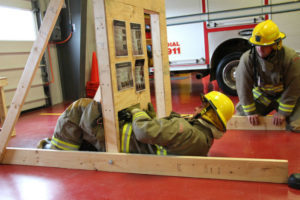
Core strengthening is important in order to prevent unnecessary back rotations and injuries. For example, 90% of the time firefighters do not carry objects in both sides with equal weights. It is always, either an ax on one hand and a kid on another. There is a need to improve your core muscles greatly, to enhance back stabilization.
Here are examples of Core strengthening exercises:
- Kettlebell or dumbbell single-arm or double-arm swing
- Lunge to dumbbell shoulder press
- Split squat to dumbbell shoulder press
- Standing single-arm dumbbell press
- Swiss ball alternating arm chest press
- Single-arm dumbbell row
- Split squat Single leg with a dumbbell
- Deadlift Single leg with a dumbbell reach
- Single-leg sit to standing with a dumbbell
Also, core strengthening is very important. Because a scene of a fire can be very chaotic. Firefighters must learn how to kick a door open, carry a small child or a grown adult even and also climb a tree to save a kitty cat. In able to do this all, you need to have strong core muscles. Here are additional exercise to further improve your core muscles:
- Russian twist
- Plank with reach
- Side plank with side raise
- Cable chop
- Crunch to medicine ball throw
Strengthen Your Back Muscles
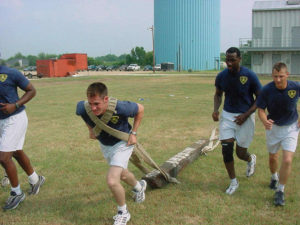
If you need to work on back stabilization and core muscles, it is without a doubt that back muscles are vital too. Your shoulders and core can be overstretched and overused by all the chaos that is going on during a fire mission. So, it will be for a firefighter’s best advantage to also know how to work the back muscles.
Strengthening your back muscles can help you carry heavy loads easier because it stabilizes your shoulder blades. Basically, the movement for this exercise is to move your shoulders up and down.
Here are sample exercises to strengthen your back muscles:
Additional Key Areas for Firefighter Training
Statistics have shown that most cases of injuries acquired by firefighters are the back, knees and shoulders. In this matter, strength training takes a different approach to further improve strength and conditioning and alleviate cases of injuries.
Additional training is further required especially in extreme cases, as oppose to the basics. Sometimes, firefighters come across fire victims that weigh between 300 to 500 pounds. Thus, firefighters are prone to lower-back injuries because of lifting these heavy residents to save them. The picture now becomes clearer that firefighters indeed to be as invincible as they can be. They are literally like our Marvel superheroes who are trying to save peoples lives. Also, cats who often get stuck in trees for reasons we can never understand.
The firefighter’s injuries are results of poor muscle coordination in the back and core area. Furthermore, they often break or tear their hamstrings because of no-to-little stretches. Most importantly, due to lack of training which enables them to execute improper techniques while on a fire mission.
Firefighter Training that Increases Credibility and Versatility
Reverse Hyper Extensions
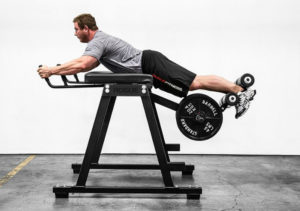
You need a machinery to be able to do this equipment. This targets your hamstrings and leg muscles.
How to do it:
- Start off with placing an appropriate weight on the machine that suits your skill level.
- Next, positioning your feet between the pads.
- Lay your upper body on the pad. However, your hips down to your legs should hang off from the pad.
- Grasp the handles on the front to stabilize yourself on top of the pad and to hold the position.
- To begin the exercise, pull your legs forward as you flex your hips.
- Next, just reverse the whole movement by extending your hips as you kick your legs to the back.
- Always remember that you should never overextend your hips while doing this movement. Which means you must put like a stoppage on your hips to not complete the whole reversing motion.
- Repeat for prescribed number of repetitions.
Glute Ham Raises
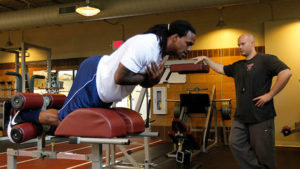
A machine is also necessary to acquire optimum results from this workout. The Glute Ham Raise targets your hamstrings, lower back, glutes and calves. Working all these four body parts will result to better posterior muscle coordination. Thus, making it an advantage for a firefighter to perform while on the move.
How to do it:
- Start by adjusting the equipment according to your body weight and size.
- As you lie facing the floor, place your feet on the plates, in between the rollers.
- Your knees should be positioned just right behind the pads.
- The exercise begins with your upper body positioning at the bottom. This is your starting position.
- Next, you lift your upper body up from the bottom.
- Complete the motion until you flex your knees and you are positioned vertically. Along this, you should arch your back as well.
- You can use your toes to aid you when pulling your upper body up.
- Reverse the motion as you return your body back to the starting position.
- Repeat for prescribed number of repetitions.
Stiff Legged Deadlift
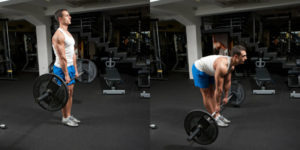
For this particular Firefighter training, you may need a barbell. This will also target your hamstrings and knees.
How to do it:
- Start off with grabbing the bar of barbell while using an overhand grip.
- Next, pick up the barbell from the ground as you stand with back straight. Stand in a shoulder-width stance with the knees slightly bent. This is your starting position.
- In order to begin the exercise, lower the barbell down just right above your feet. However, when doing this movement, your knees and legs are remained stationary. Which means, your upper body will be doing all the actions and movements.
- As you lower your upper body, trying to lower the barbell down as well, always keep your back straight.
- For maximum results, it would be best if you can be able to flatten your upper body horizontally to create a perpendicular relationship with your legs.
- Hold the position for about a second or two and slowly lift your upper body up to return to the starting position.
- Repeat for prescribed number of repetitions.
Rear Delt Row
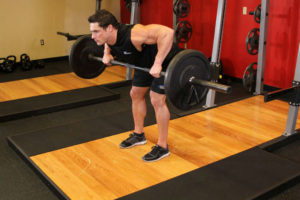
You can either use a dumbbell or barbell for this firefighter training exercise. If non of the equipment are available, you can utilize a sandbag for this one. The Brute Force sandbags have been making the top for one of the high quality sandbag out in the market. This will develop and build your rear delts and sub scapular muscles.
How to do it:
- Begin by grabbing the barbell off the ground using an overhand grip.
- As you lift the barbell off from the ground, you are to leave a few inch gap between the floor and the barbell. Your arms should be straight and extended as they hang down while holding the barbell.
- As you do so, keep your back naturally arched and your knees bent slightly. Ensure that your torso is directly paralleled to the floor.
- Next, bend your elbows very slightly and position them away from your body. Now, this will be your starting position.
- Afterwards, pull the barbell up towards your chest as you ensure that your elbows are paralleled to your torso. In other terms, your elbows should create a 90 degree angle. Exhale as you do this movement.
- Lastly, inhale as you return the barbell back down going back to the starting position.
- Repeat for prescribed number of repetitions.
Bent Over Row
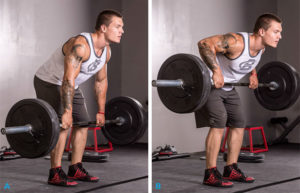
Same as with the Rear delt row, you can either opt to use a barbell or dumbbells for this exercise. If non of the equipment are available, you can utilize a sandbag for this one. The Brute Force sandbags have been making the top for one of the high quality sandbag out in the market. The Bent Over row is a firefighter training exercise that targets lats and traps. Generally, your shoulders.
How to do it:
- Start off by grabbing the barbell with an overhand grip.
- Pull the barbell up as you stand up while keeping your knees slightly bent. If your torso awhile ago was directly paralleled to the floor. Now, you are to pull your upper body up more. Which means, your back should be straight and bent slightly following a 45 degree angle.
- The barbell should be positioned right in front of you. Your arms should be free hanging perpendicularly from the floor. Keep your arms fully extended and straight. This will now be your starting position.
- Next, lift the barbell towards your core area while keeping your back and knees stationary. Your elbows should slightly overpass your back to reach optimum capacity. Also, keep your elbows as close to your body as you can.
- Inhale as you slowly lower down the barbell going back to the starting position.
Wide-grip Lat Pulldown
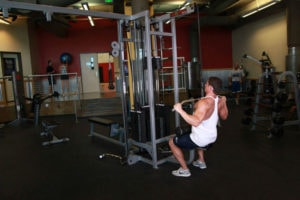
The Lat Pulldown training exercise is closely like the combination of both the rear delt row and the bent over row. This particular exercise targets the rear delts, the lats and majority of the muscle groups found in the back.
What you need to fulfill this exercise is a cable pulldown machine.
How to do it:
- Start off by positioning yourself on the cable pulldown machine.
- Do not forget to adjust the knee pads at your prescribed comfort level.
- Next, grab the bar with an overhand grip. In other terms, your palms should face forward. Your arms should be fully extended and straight.
- Position your back slightly leaning backwards creating a small arch and stick your chest out. This will be your starting position.
- Now, exhale as you pull down the bar until it slightly reaches your chest.
- Lastly, inhale as your return the bar going back to the starting position.
- Repeat for number of prescribed repetitions.
How does Firefighter Training Connect to Cardio and Crossfit?
If up to this point, you are still confused on how a firefighter’s training can correlate and be of an advantage to cardio exercises and crossfit trainings. Then, let me sum it all up for you.
A firefighter needs to train in order to build stamina, speed, power, strength and coordination. Thus, firefighter training evolved to provide extensive training for firefighters to develop high quality performance in every fire mission they will respond to. The firefighter training consists of workout regimens that are not far off from what cardio and crossfit training uses.
Furthermore, we can learn a lot from the Firefighter training because they are a bit more intensed compared to the regular crossfit and cardio exercises. Why? Because they deal with victims that can weigh of up to 500 lbs, they carry unequal weights of heavy loads from both hands and they wear a uniform that has an approximate weight of 10-15 kg.
All in all, because of the intensity and extensiveness required from the training of firefighters, we, as regular people will be challenged significantly. The overall state of the body would have to adjust to the extremities required from a firefighter training.
